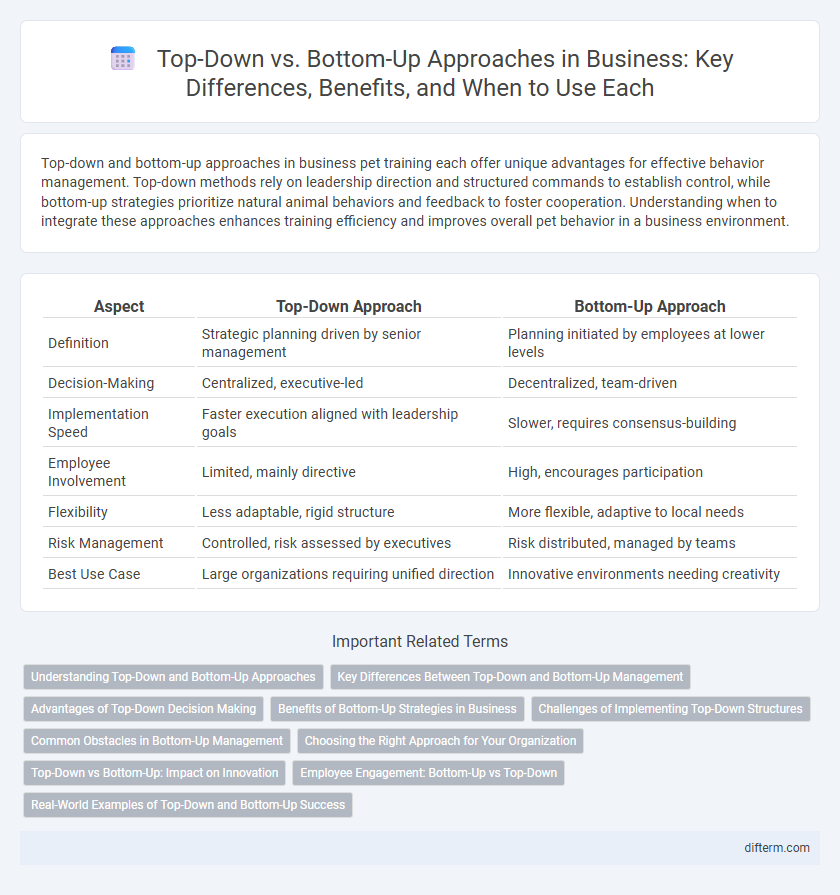Top-down and bottom-up approaches in business pet training each offer unique advantages for effective behavior management. Top-down methods rely on leadership direction and structured commands to establish control, while bottom-up strategies prioritize natural animal behaviors and feedback to foster cooperation. Understanding when to integrate these approaches enhances training efficiency and improves overall pet behavior in a business environment.
Table of Comparison
| Aspect | Top-Down Approach | Bottom-Up Approach |
|---|---|---|
| Definition | Strategic planning driven by senior management | Planning initiated by employees at lower levels |
| Decision-Making | Centralized, executive-led | Decentralized, team-driven |
| Implementation Speed | Faster execution aligned with leadership goals | Slower, requires consensus-building |
| Employee Involvement | Limited, mainly directive | High, encourages participation |
| Flexibility | Less adaptable, rigid structure | More flexible, adaptive to local needs |
| Risk Management | Controlled, risk assessed by executives | Risk distributed, managed by teams |
| Best Use Case | Large organizations requiring unified direction | Innovative environments needing creativity |
Understanding Top-Down and Bottom-Up Approaches
Top-down and bottom-up approaches represent contrasting strategies in business decision-making and project management. Top-down involves leadership setting strategic goals and directives that cascade down through organizational layers, ensuring alignment with overarching objectives. Bottom-up emphasizes input and insights from frontline employees or lower management, fostering innovation and practical problem-solving grounded in real-world operational experience.
Key Differences Between Top-Down and Bottom-Up Management
Top-down management involves decision-making centralized at the executive level, where directives flow downward to employees, ensuring clear authority and streamlined execution. Bottom-up management empowers employees at all levels to contribute ideas and solutions, fostering innovation and enhancing engagement by valuing frontline insights. Key differences include the source of decision authority, communication flow, and flexibility in adapting strategies based on organizational hierarchy or collective input.
Advantages of Top-Down Decision Making
Top-down decision making streamlines organizational processes by providing clear direction from senior leadership, enhancing alignment with strategic goals and accelerating implementation. This approach facilitates rapid decision-making in complex business environments, reducing ambiguity and ensuring consistent messaging across departments. Centralized authority in top-down decision making enables efficient resource allocation and swift responses to market changes, boosting overall organizational agility.
Benefits of Bottom-Up Strategies in Business
Bottom-up strategies in business empower employees by harnessing their insights, leading to increased innovation and improved problem-solving. This approach fosters stronger team collaboration and engagement, which can enhance productivity and morale. Companies adopting bottom-up methods often experience greater adaptability and responsiveness to market changes.
Challenges of Implementing Top-Down Structures
Implementing top-down structures in business often faces challenges such as reduced employee autonomy, which can hinder innovation and morale. Communication bottlenecks arise as decisions flow through hierarchical levels, delaying responsiveness to market changes. Resistance from middle management can occur due to perceived loss of influence, impacting overall organizational agility and effectiveness.
Common Obstacles in Bottom-Up Management
Common obstacles in bottom-up management include resistance to change from middle management, lack of clear communication channels, and limited employee empowerment. Decision-making delays often arise due to the need for consensus, which can hinder responsiveness. Insufficient training and resources further challenge the effective implementation of bottom-up strategies in organizations.
Choosing the Right Approach for Your Organization
Choosing the right approach between top-down and bottom-up management significantly influences organizational effectiveness and employee engagement. Top-down strategies emphasize centralized decision-making and clear directives from leadership, ideal for uniformity and quick execution in large enterprises. In contrast, bottom-up approaches foster innovation and collaboration by leveraging employee insights, benefiting companies that prioritize adaptability and decentralized control.
Top-Down vs Bottom-Up: Impact on Innovation
Top-down innovation drives strategic alignment by channeling executive vision into focused projects, accelerating decision-making and resource allocation. Bottom-up innovation leverages employee insights and grassroots creativity, fostering diverse ideas and adaptability in product development. Combining both approaches enhances organizational agility and sustained competitive advantage in dynamic markets.
Employee Engagement: Bottom-Up vs Top-Down
Employee engagement thrives when bottom-up approaches are prioritized, empowering staff to contribute ideas and influence decision-making, thereby fostering ownership and motivation. Top-down strategies provide clear objectives and leadership alignment but often risk alienating employees if their input is overlooked, leading to disengagement. Integrating bottom-up feedback loops within top-down frameworks optimizes engagement by balancing strategic direction with grassroots innovation.
Real-World Examples of Top-Down and Bottom-Up Success
Top-down approaches drive organizational change through executive directives, seen in Apple's strategic innovation led by top management; bottom-up methods harness employee insights, exemplified by Google's 20% time policy that fosters grassroots creativity. Companies like Toyota integrate both, using top-down planning with bottom-up continuous improvement (kaizen) to achieve operational excellence. Real-world success highlights how blending hierarchical vision with employee-driven innovation optimizes business performance and adaptability.
top-down vs bottom-up Infographic

 difterm.com
difterm.com